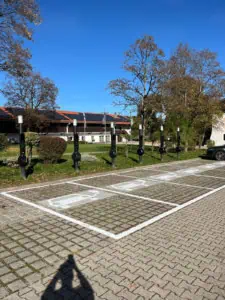E-charging stations: the frontrunners
Busy times at the e-charging points. Fast chargers, of course, eight spaces next to each other – and charging is buzzing. “When the weather is nice, we can get 130 to 140 charges on a weekend,” says Olaf Gühring. The man is not a petrol station operator but a golf course owner. However, the Bergkramerhof golf course, which he bought with his wife in 2023, is a two-minute drive from the A95 towards Garmisch-Partenkirchen. It is one of the busiest highways in Bavaria, heading towards the mountains or Brenner. For Gühring, this means: “500 charges per month are standard”. Primarily as he also operates six charging points with 11/22 kW in addition to eight fast-charging stations with 300 kW. This makes Bergkramerhof the leader in Bavaria, alongside the Munich Eichenried golf course, regarding the number of e-charging stations on offer. Only the Mainz Golf Club, which opened a charging park with 28 charging points in August, surpasses this offer in Germany. At GC Eichenried, golfers have 20 charging points with 11 KW. “First we had two, then ten, then they were full at some point and now there are 20 this summer,” explains Managing Director Wolfgang Michel.
Michel and Gühring’s approaches have the same initial idea but are otherwise completely different. Both wanted to get involved in e-mobility and take an innovative approach. Gühring called EnBW because the company is one of Germany’s largest providers of charging stations on highways. “EnBW sent a team over, checked the situation and assessed it positively. Then we got started.” Bergkramerhof provided the space, now receives a three-figure lease per charging point, and otherwise had nothing to do with installing the infrastructure or handling the charging processes.” While the fast chargers are used mainly by non-golfers, golfers’ cars are usually parked at the 11 KW stations because a round of golf takes a few hours anyway. “Now we’re adding six more bike charging points,” says Gühring with satisfaction. Then, the charging park on the golf course next to the highway will be completed. While charging, non-golfers usually go to the golf club’s restaurant or walk along the golf course.
No wallbox? Charging in the club
Michel’s target group, on the other hand, are members of the Eichenried Golf Club and greenfee golfers. “We don’t need fast chargers; we’re far too far away from the highway,” he says. However, the wide range of e-charging stations is particularly popular with golfers who live in the city centre or residential areas and don’t always have access to their own wall box. “This is a service that we simply want to offer,” explains the Managing Director, who is seeing a steady increase in demand for e-charging points. “If we assume an increasing market penetration of e-cars in the future, 20 charging points are by no means too many.” No, neither Michel nor Gühring are making a big profit with the charging points. However, it quickly becomes clear during the conversation that this was not their main driving force. It’s more about their belief in innovation, their enthusiasm for modern golf courses and their attempt to make golf courses more diverse.
Subscribe to our newsletter!
News & trends about sustainability in golf
Is this a nationwide trend? There are quite a few e-charging points at golf courses. More than 270 in total at Bavarian golf courses. No, says Andreas Dorsch, Managing Director of the German Golf Management Association and one of the best experts on the German scene. “I see more of a cautious trend here,” he says. “At many golf clubs, one or two charging points are nice to have, but there hasn’t been a real jolt through the industry yet.”
On the other hand, anyone who talks to Gühring and Michel and follows the installation of the large charging park in Mainz will notice that the general mood here is positive. The topic of environmental protection is being consistently continued with the topic of e-mobility. The motivation of those responsible is clearly contagious: “Our members think it’s great,” says Gühring. Michel’s conclusion is no different. In both cases, the following applies: when it comes to e-mobility, the company is a German leader.








